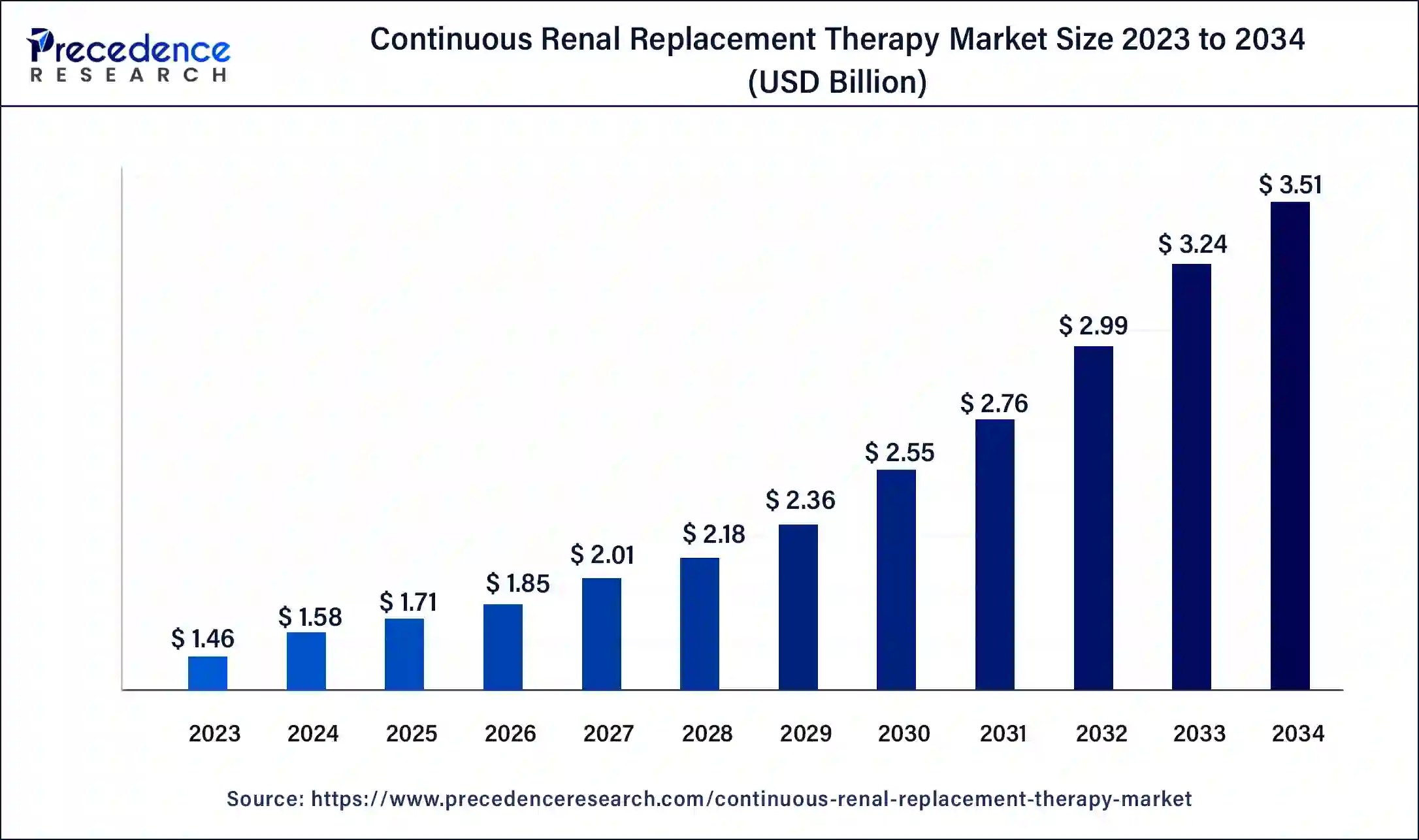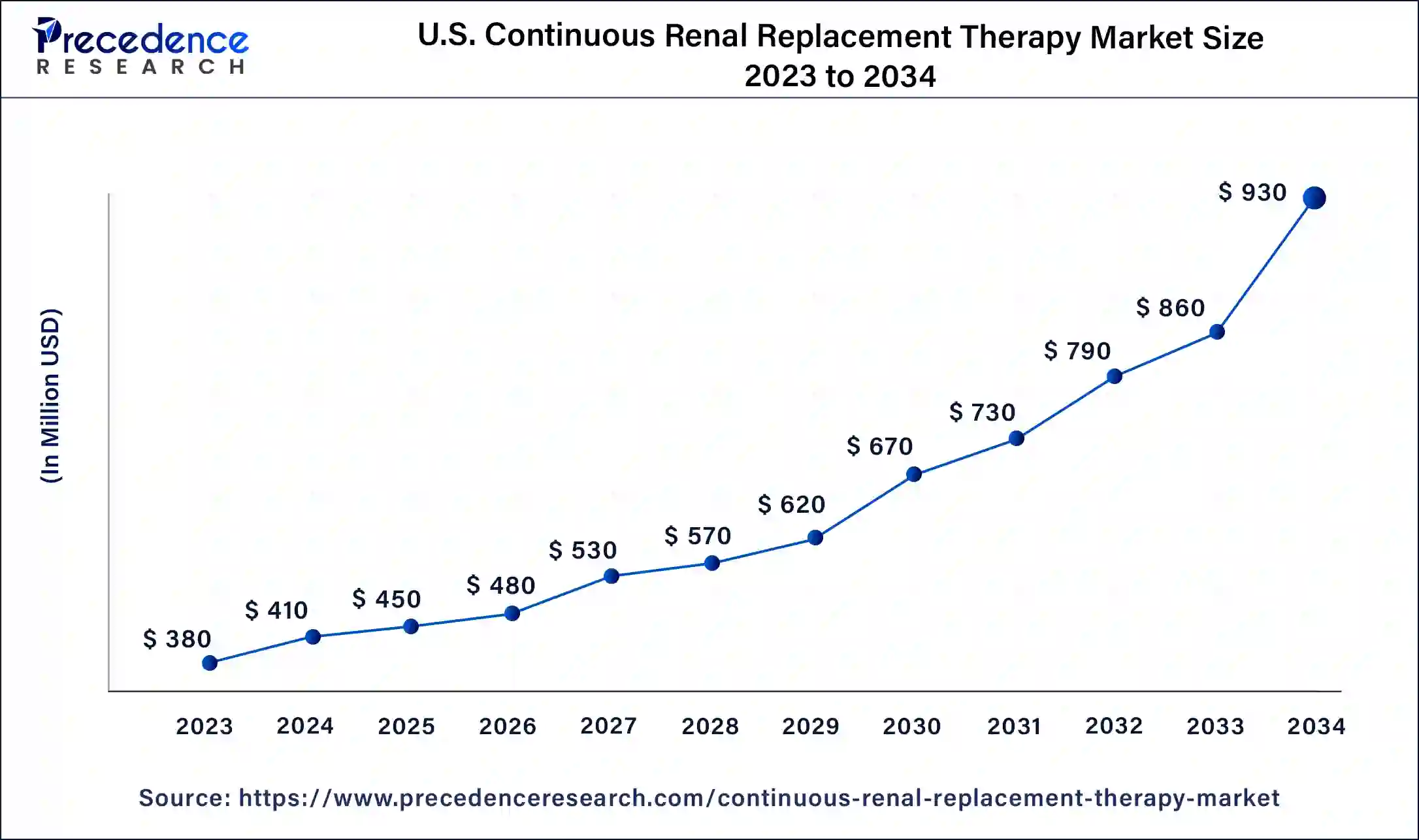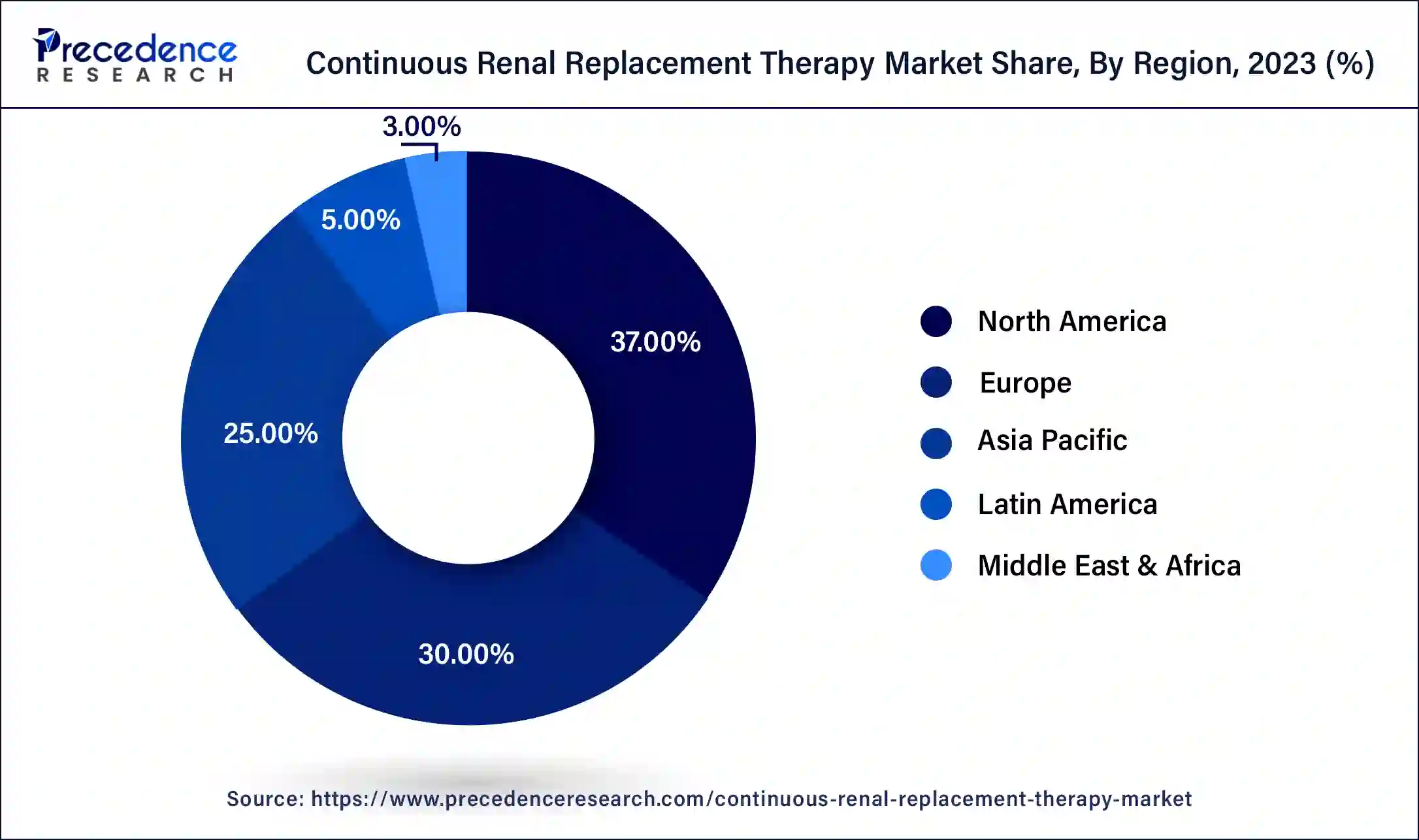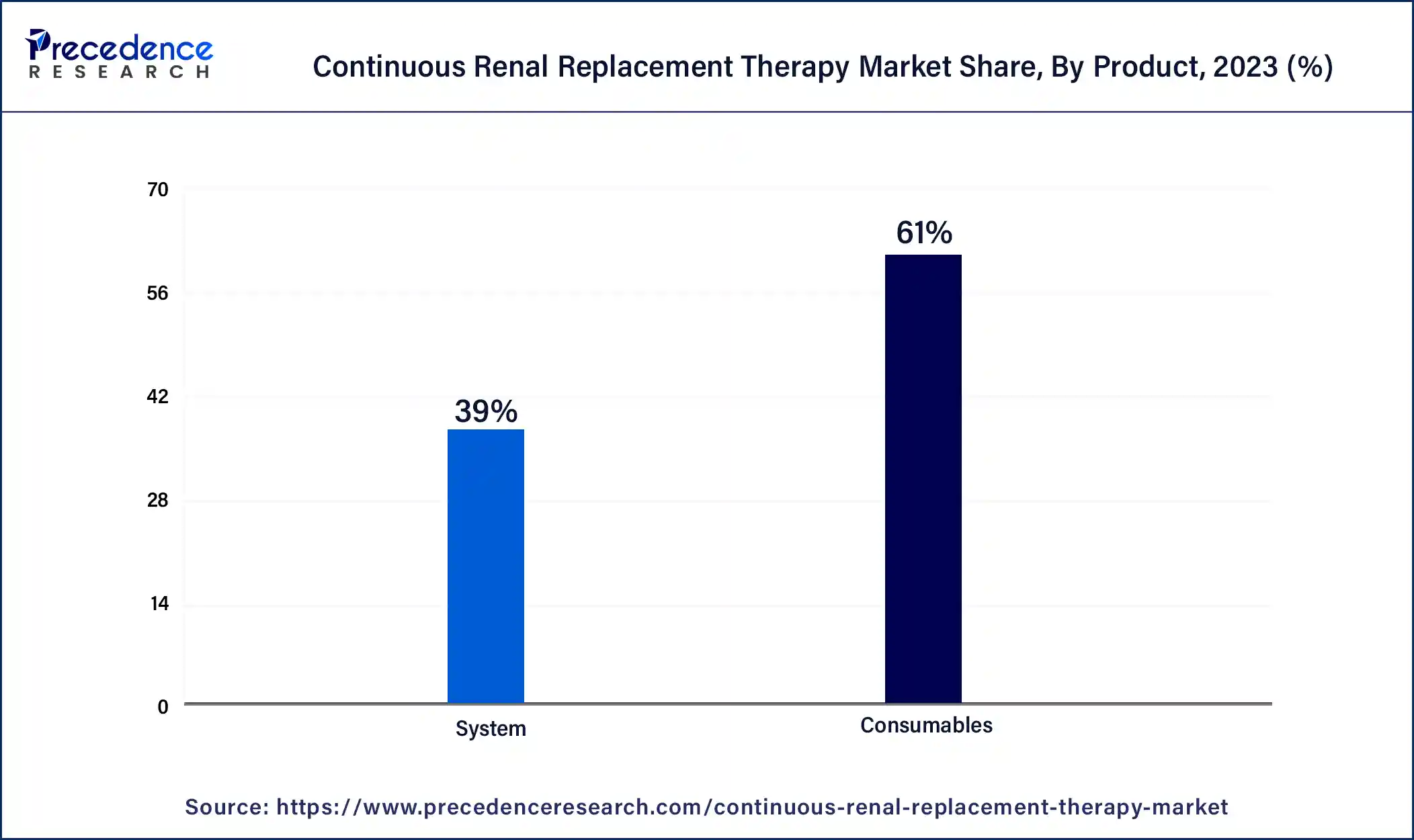January 2025
Continuous Renal Replacement Therapy Market (By Product: System, Consumables; By Modality: Slow Continuous Ultra-Filtration (SCUF), Continuous Venovenous Hemofiltration (CVVH), Continuous Venovenous Hemodialysis (CVVHD), Continuous Venovenous Hemodiafiltration (CVVHDF)) - Global Industry Analysis, Size, Share, Growth, Trends, Regional Outlook, and Forecast 2024-2034
The global continuous renal replacement therapy market size accounted for USD 1.58 billion in 2024 and is expected to reach around USD 3.51 billion by 2034, expanding at a CAGR of 8.3% from 2024 to 2034. The North America continuous renal replacement therapy market size reached USD 540 million in 2023.

The U.S. continuous renal replacement therapy market size was estimated at USD 380 million in 2023 and is predicted to be worth around USD 930 million by 2034, at a CAGR of 8.5% from 2024 to 2034.

North America held the largest revenue share of 37% in 2023. North America dominates the continuous renal replacement therapy (CRRT) market due to factors such as a high prevalence of renal diseases, well-established healthcare infrastructure, and substantial investments in advanced medical technologies. The region benefits from a robust research and development environment, fostering technological innovations in CRRT. Additionally, a proactive regulatory framework and increasing awareness among healthcare professionals contribute to the widespread adoption of CRRT in North America, consolidating its major share in the global market.
Asia-Pacific is estimated to observe the fastest expansion. The Asia-Pacific region dominates the continuous renal replacement therapy market due to factors such as a high prevalence of kidney diseases, an aging population, and increasing awareness of advanced renal care. Growing healthcare infrastructure, rising healthcare expenditure, and the adoption of innovative CRRT technologies further contribute to the market's prominence. Additionally, strategic initiatives by key market players to expand their presence in Asia-Pacific and collaborations with local healthcare providers drive the region's major share in the CRRT market.

Market Overview
Continuous renal replacement therapy (CRRT) is an advanced medical procedure designed for critically ill patients dealing with acute kidney issues. Unlike standard intermittent hemodialysis, CRRT offers a continuous and gradual elimination of waste products, extra fluids, and electrolytes from the patient's bloodstream. This therapy is particularly beneficial for individuals who may not tolerate the rapid fluid shifts associated with conventional dialysis.
CRRT involves the use of a machine that continuously circulates a patient's blood through a specialized filter, known as a hemofilter or dialyzer. This filter allows for the removal of toxins and fluid in a gradual and controlled manner, mimicking the natural functioning of the kidneys. CRRT is commonly employed in intensive care units for patients who are hemodynamically unstable or critically ill, requiring a gentler and more sustained approach to renal replacement therapy. This method helps maintain fluid balance and electrolyte levels, contributing to the overall stabilization of the patient's condition while allowing time for the kidneys to recover.
| Report Coverage | Details |
| Growth Rate from 2024 to 2034 | CAGR of 8.3% |
| Market Size in 2023 | USD 1.46 Billion |
| Market Size in 2024 | USD 1.58 Billion |
| Market Size by 2034 | USD 3.51 Billion |
| Largest Market | North America |
| Base Year | 2023 |
| Forecast Period | 2024 to 2034 |
| Segments Covered | By Product and By Modality |
| Regions Covered | North America, Europe, Asia-Pacific, Latin America, and Middle East & Africa |
Increasing incidence of acute kidney injury (AKI) and aging population
The increasing incidence of Acute Kidney Injury (AKI) and the aging population collectively drive a surge in demand for continuous renal replacement therapy (CRRT). AKI, often a consequence of critical illnesses or medical interventions, has witnessed a global uptick, necessitating advanced renal care solutions. CRRT proves instrumental in managing AKI by providing a continuous and controlled removal of waste products and fluids from the bloodstream, catering to patients who may not tolerate the rapid fluid shifts associated with conventional dialysis. Simultaneously, the aging demographic contributes significantly to the demand for CRRT.
As individuals age, the likelihood of encountering renal issues rises, necessitating specialized renal interventions. CRRT, with its ability to provide a gentle and sustained approach to renal replacement therapy, aligns with the specific needs of elderly patients, further fueling its adoption in healthcare settings. The combination of these factors underscores CRRT's pivotal role in addressing the evolving healthcare needs of a population grappling with an increased prevalence of acute kidney injuries and age-related renal challenges.
High treatment costs and preference for conventional dialysis
The high treatment costs associated with continuous renal replacement therapy (CRRT) stand as a significant restraint on market demand. The expenses linked to CRRT procedures, equipment, and ongoing maintenance can be prohibitive for both healthcare facilities and patients. This financial burden limits the accessibility of CRRT, particularly in regions with budget constraints and healthcare systems facing economic challenges. As a result, cost considerations may lead healthcare providers and institutions to opt for more cost-effective alternatives, thereby impeding the widespread adoption of CRRT.
Additionally, the preference for conventional dialysis methods over CRRT acts as a notable restraint. Despite the advantages offered by CRRT, established practices and familiarity with traditional intermittent hemodialysis may create resistance to change among healthcare professionals and facilities. This preference for conventional methods, driven by historical practices and comfort levels, can hinder the broader acceptance and integration of CRRT into routine renal care protocols, impacting its market demand and adoption.
Home-based CRRT solutions and pediatric applications
Home-Based continuous renal replacement therapy (CRRT) solutions represent a significant opportunity in the market by addressing the demand for more accessible and patient-friendly renal care. The development of portable and user-friendly CRRT devices for home use allows patients to receive continuous renal therapy in the comfort of their homes, reducing the need for frequent hospital visits. This not only enhances patient convenience but also opens a new market segment, especially for individuals who may prefer or require home-based care.
Furthermore, the expansion of CRRT applications into pediatrics offers another avenue for market growth. Pediatric applications of CRRT cater to the specific needs of young patients with acute kidney injury or other renal conditions. The adaptation of CRRT systems to meet the unique requirements of pediatric care not only addresses a critical medical need but also creates opportunities for specialized solutions in the pediatric renal care segment. These developments align with a broader trend towards personalized and home-based healthcare, shaping the future landscape of the continuous renal replacement therapy market.
In 2023, the consumables segment had the highest market share of 61% on the basis of the product. In the continuous renal replacement therapy (CRRT) market, the consumables segment includes essential components regularly replaced during therapy, such as filters, tubing, and solutions. The consumables segment is witnessing a trend toward the development of more efficient and durable materials, ensuring prolonged use and cost-effectiveness.
Manufacturers are focusing on innovations to enhance the performance and lifespan of consumables, aligning with the growing demand for sustainable and economically viable solutions in the CRRT market, ultimately improving the overall efficiency and accessibility of continuous renal replacement therapy.

The system segment is anticipated to expand at a significant CAGR of 9.1% during the projected period. The system segment in the continuous renal replacement therapy (CRRT) market refers to the comprehensive machines or devices used to perform the therapy. These systems typically include components such as pumps, filters, and monitors, working together to facilitate the continuous removal of waste products and excess fluids from the patient's bloodstream.
A notable trend in this segment involves continuous technological advancements, with an emphasis on creating more efficient, user-friendly, and integrated CRRT systems. Ongoing innovations aim to enhance treatment outcomes, improve patient experiences, and streamline the operational aspects of delivering continuous renal replacement therapy.
According to the modality, the continuous venovenous hemofiltration (CVVH) segment held a 32% revenue share in 2023. Continuous Venovenous Hemofiltration (CVVH) is a modality within continuous renal replacement therapy that involves the continuous removal of waste products and excess fluids from the blood. It utilizes a combination of convective and diffusive mechanisms to achieve a more gradual and continuous filtration process.
A trend in the CVVH segment involves the increasing adoption of precision technologies, enhancing therapy customization. The integration of advanced monitoring and control features improves the precision and efficiency of fluid removal, contributing to better patient outcomes and driving the evolution of CVVH within the broader CRRT market.
The continuous venovenous hemodiafiltration (CVVHDF) segment is anticipated to expand fastest over the projected period. Continuous Venovenous Hemodiafiltration (CVVHDF) is a modality in continuous renal replacement therapy that combines hemodialysis and hemofiltration. It involves the continuous removal of waste products, excess fluids, and electrolytes from the blood using a combination of diffusion and convection. The CVVHDF segment in the CRRT market is witnessing a trend towards increased adoption due to its ability to provide comprehensive solute clearance and effective fluid management. This modality offers a more holistic approach to renal replacement therapy, contributing to its growing prominence in critical care settings.
Segments Covered in the Report
By Product
By Modality
By Geography
For inquiries regarding discounts, bulk purchases, or customization requests, please contact us at sales@precedenceresearch.com
No cookie-cutter, only authentic analysis – take the 1st step to become a Precedence Research client
January 2025
March 2025
October 2024
October 2024